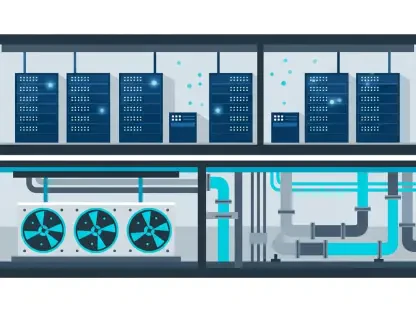In a transformative stride toward shaping the digital landscape of the Asia-Pacific region, Amazon has committed a staggering $4.4 billion (NZ$7.5 billion) to establish New Zealand’s first Amazon Web Services (AWS) data center region, marking a pivotal moment for technological advancement. This ambitious 15-year project, now operational, is far more than a mere infrastructure endeavor; it represents a strategic push to address critical challenges like high latency and data residency issues that have long hindered progress in the Australia and New Zealand (ANZ) corridor. By laying down this foundation, Amazon is not only enhancing access to cutting-edge cloud services but also setting the stage for a wave of innovation, economic growth, and sustainability. The initiative promises to redefine how businesses operate in this part of the world, positioning New Zealand as a key player in the global digital economy with far-reaching implications for industries and communities alike.
Powering Up Cloud Capabilities for a Tech-Driven Era
The establishment of a robust local cloud infrastructure under this massive AWS investment is a game-changer for New Zealand’s technological ecosystem. With multiple Availability Zones designed for maximum reliability and resilience, the data center addresses the persistent problem of latency that has slowed down digital operations for years. Businesses, ranging from small startups to large enterprises, now have access to real-time AI applications such as predictive analytics and autonomous systems without the delays that once hampered efficiency. This localized setup ensures that data processing happens closer to home, meeting stringent residency requirements and enabling faster, more responsive services. The impact is already visible in sectors like telecommunications and retail, where companies can enhance customer interactions through seamless, high-speed tech solutions, ultimately driving operational excellence and market competitiveness across the board.
Equally significant is the way this infrastructure empowers innovation at a granular level for New Zealand’s business landscape. The reduced lag and improved data handling capabilities mean that firms can experiment with and deploy advanced tools like machine learning models and generative AI without needing to rely on distant servers. This accessibility is crucial for industries that thrive on immediacy, such as finance and healthcare, where split-second decisions can make a substantial difference. Moreover, the presence of a local AWS region fosters a sense of confidence among businesses to adopt cloud technologies, knowing that support and scalability are within reach. This development is poised to create a ripple effect, encouraging a broader digital transformation that aligns with global standards while catering to unique regional needs, thus positioning the nation as a hub of technological progress in the Asia-Pacific arena.
Fueling Economic Prosperity and Innovation
The economic implications of Amazon’s investment in New Zealand are nothing short of monumental, with projections estimating a NZ$10.8 billion boost to the nation’s GDP over the next 15 years. Alongside this financial surge, the project is expected to generate around 1,000 jobs, providing a significant lift to local employment and skill development. These figures underscore the data center’s role as a catalyst for growth, extending beyond direct monetary contributions to create a fertile ground for business expansion. By offering a platform for cutting-edge cloud and AI technologies, the initiative enables local companies to innovate and scale, thereby contributing to a dynamic economy that can compete on a global stage while addressing domestic demands with tailored solutions.
Beyond raw numbers, the data center serves as an incubator for entrepreneurial spirit and technological breakthroughs across various sectors. Small businesses and startups, often constrained by limited resources, now have the opportunity to leverage AWS tools to streamline operations and reach wider markets, fostering a culture of creativity and resilience. This mirrors trends seen in Australia, where firms adopting AI through AWS platforms have reported revenue increases of up to 34%, highlighting the tangible benefits of accessible tech infrastructure. The synergy between economic growth and innovation becomes a driving force, as enhanced digital capabilities allow New Zealand businesses to tap into international opportunities, attract investment, and build a reputation for forward-thinking practices, ultimately strengthening the region’s economic fabric in a sustainable manner.
Championing Sustainability in Digital Expansion
A standout feature of this AWS data center project is its unwavering commitment to environmental sustainability, setting a benchmark for tech developments in the ANZ region. Powered entirely by renewable energy sourced from Mercury NZ’s Turitea South wind farm, the facility aligns seamlessly with Amazon’s broader goal of achieving water positivity by 2030. This dedication to green energy resonates deeply with regional priorities around net-zero targets, offering a model for how large-scale tech projects can coexist with ecological responsibility. Reports further emphasize that migrating AI workloads to AWS infrastructure can reduce carbon emissions by as much as 94%, providing a compelling incentive for businesses to pursue growth without compromising environmental integrity.
This focus on sustainability extends beyond energy sourcing to influence broader industry practices within New Zealand and its neighboring markets. The data center’s eco-friendly design encourages companies to rethink their own operational footprints, integrating greener technologies and processes as they adopt cloud solutions. This shift is particularly impactful in a region increasingly scrutinized for its environmental policies, positioning the AWS initiative as a leader in balancing technological advancement with planetary stewardship. By embedding sustainability into the core of its operations, the project not only addresses immediate digital needs but also contributes to long-term ecological goals, fostering a harmonious relationship between innovation and the environment that other regions might emulate.
Nurturing Talent and Regional Synergies
The investment by AWS goes well beyond physical infrastructure, aiming to bridge the digital skills gap that has challenged the ANZ region for years. Drawing from a successful blueprint in Australia, where over 400,000 individuals have been trained in digital competencies since 2017, similar programs are expected to roll out in New Zealand, equipping the workforce with essential tools for an AI-driven future. This emphasis on talent development ensures that the benefits of the data center are not limited to corporations but extend to individuals, fostering a skilled labor pool capable of driving innovation and meeting the demands of a rapidly evolving tech landscape, thus securing long-term regional competitiveness.
Complementing this focus on skills is the strategic alignment with broader regional goals, as seen in AWS’s additional $20 billion commitment to Australia by 2029. This dual-axis approach positions New Zealand as a vital gateway for Oceania’s digital ambitions while enhancing connectivity and collaboration across the ANZ corridor. Partnerships, such as the “Top Secret” cloud service with the Australian government, further solidify AWS’s role in supporting critical infrastructure and national security. These efforts collectively create a robust framework for digital transformation, ensuring that the benefits of advanced technology permeate through economies, governments, and societies, establishing a cohesive network of innovation that promises sustained growth and resilience in the years ahead.









